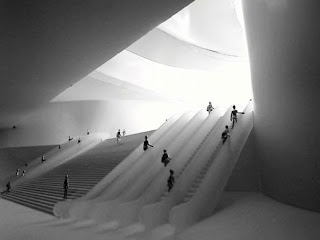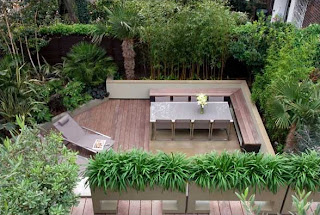
Architecture is evocative.
Navigating around the bend of the river a massive metal clad arch dwarfs the boat, the river, the trees, and the skyline. This arch demands attention. It cannot go unnoticed. Humbled by its presence, one can not only but wonder what this "thing" is or does and but also be curious about the premise of its existence. This "thing" commands one to notice its presence. It insists one recognize its power. It represents the zeitgeist of post-war America - a victorious America. The St. Louis Arch, designed by architect Eero Saarinen, creates a sense of awe through layered effects. These characteristics can be quantified, listed, and evaluated. There is no formula to be followed or regulation on the use of these characteristics in the creation of quality Architecture.
1. Originality: The creation of something unique and unprecedented. 2. Timelessness: The consciousness of timelessness does not follow a specific rule-set or path. For this discussion it will be defined as an outcome of the sublime. 3. Hybridization: A more specific form of originality - the creation of "new" through the combination of two seemingly unlinked normative conditions.
Before further discussion and exploration ensues, it must be stated that the symbolism of the St. Louis Arch is not what is under investigation, rather the role of architecture as an evocative object is what we are striving to ascertain.
According to Merriam-Webster, the definition of sublime is simple: awe inspiring. (Un)Fortunately, the implications and understanding of what can be defined as sublime is not so straight forward. "...sublime is to be found in an object even devoid of form, so far as it immediately involves, or else by its presence provokes, a representation of limitlessness."
A basic mathematical relationship has been derived to explore the myriad definitions of sublime: "limitlessness" > "awe inspiring." These two definitions are not equal. A simple definition of the sublime only succeeds in limiting the intensity of everything it had the ability to encompass. Many great works of architecture are timeless. These structures create a constant newness though evocation. Timelessness is a working of the sublime. Kant's definition of the sublime is what architect's strive to achieve through their work.
Architectural competitions have always attempted to allow the architect to express various theories and stylistic approaches that are not always possible or even desirable with a pragmatic client. These competition entries, whether built or not, exert an amazingly strong influence on the development of the field of architecture. The 1947 Jefferson National Expansion Memorial Competition fits into this category.
Eero Saarinen's winning entry for the 1947 competition to design a monument to honor westward expansion is one of these entities. The St. Louis Gateway Arch, a parabolic arch, grew to become not only a symbol for the city of St. Louis, Missouri, but also to epitomize the strength of post-war America. Innovation was the key to the success of Saarinen's competition entry. The Gateway Arch can be seen to fit into the general categories of monument, sculpture, and architecture. This cross-hybridization between disciplines is the reason it still remains iconic. To the laymen, the Gateway Arch can be placed in the category of architecture based on the fact that it is inhabitable. More so, the thing that defines this structure and all great structures is the real life experiential quality. The Gateway Arch is thus viewed as the immutable icon for the city of St. Louis. Great architecture leaves a lasting impression. This is another aspect that separates quality design from other built works - presence. Architecture has the ability, and should, to be experiential in the way that it creates something new, unforeseen, or unusual. This experiential nature can be developed and worked in various ways and disciplines within the field of architecture. Programmatic relationships, aesthetic qualities, structural innovations are all ways to create something unique in architecture.
The St. Louis Arch has a strong physiognomy. Everything that it is or is intended to be is shown from the surface. The structure is a simple parabolic curve built on an extremely large scale. The essence of tectonics and form embodies the zeitgeist of post World War II. The Arch is as much a gateway to the west as it is a symbol for St. Louis and the post-war condition of America. This monument is for all Americans to see the strength, power, and innovation of the country. It is also a symbol to the world, showing the superpower status of the United States. The visual nature of Saarenin's creation can be read by all as architecture. The sheer sense of scale, especially in contrast to the Saint Louis skyline, creates a sense of awe distinct to developments that push the envelope of innovation. To some, the line between sculpture and architecture may be disputed in regard to the Gateway Arch. It is not the architectural critics of that era who define what good architecture is. Eero Saarinen and his projects were not in critical favor during his career and have not been until recent times. His innovative style, structural technique and essence have withstood the test of time. Time is what determines whether or not a structure can be labeled as good architecture. If years pass and the now "old" structure still generates the same wonder and admiration as when it was first constructed, whether on an aesthetic or critical level, that work has passed the test of time.
"Critique of Judgment", a major work by Immanuel Kant which was published later in his career, has been and continues to be read as it pertains to aesthetics. While this interpretation requires the reader to ignore many of Kant's themes, the idea of aesthetics as being specific to beauty and the sublime is a crucial link in its relation to architecture. According to Kant, judgment lies between understanding and reason. The goal of Immanuel Kant's critiques, as stated in the introduction of "Critique of Judgment", is dedication "to uncovering and exhibiting the a priori principles of the mind and the rational structure of experience and moral practice in general."
"...there is no science of the beautiful, but only a critique. A science of the beautiful would require scientific determination and would then fail to be a judgment of taste." Judgment is the bridge between "what is and what ought to be." Kant begins by stating that the "power of judgment" forms a middle term between understanding and reason. The critical search for a principle of judgment (in the case of acts of judgment that are called aesthetic), relating to the beautiful and sublime in nature or art, is the most important item in a critique of this faculty. They "indicate an immediate bearing of this faculty upon the feeling of pleasure or displeasure according to some 'a priori' principle."
In "Critique of Judgment" Kant states that basing one's own judgment on the judgments of others shows a lack of self-determination, or heteronomy. Therefore, individual taste in itself is autonomous. A priori principles cause an immediate feeling of pleasure or displeasure which is individual to one's self. The "a priori-ness" of judgment itself allows it to hold validity. "...uncovering and exhibiting the 'a priori' principles of the mind and the rational structure of experience and moral practice in general"
"The 'power of judgment' forms a middle term between understanding and reason." The analysis of judgment and the establishment of its validity, as well as the sublime are essential to the discourse of architecture. J.M. Bernstein, in "The Fate of Art: Aesthetic Alienation from Kant to Derrida and Adorno" states that judgment can either be true or false, and not a mere expression or statement of like or dislike. "...no conceptual articulation of an object can saturate it sufficiently so as to license a valid judgment of taste."
Mark is an architect, designer, and contributor to Sinking Cities Architecture Blog.
Find more about architecture and design on http://sinkingcities.com/
Article Source: http://EzineArticles.com/?expert=Mark_E._Ford
 India is a land of beauty with a host of architectural gems, exotic hill stations, silent waterfalls, lush green forests, wildlife centuries, and a diversified image of ethnicities. With so much to explore and discover, the enchanting land has become a hot destination for tourists around the world.
India is a land of beauty with a host of architectural gems, exotic hill stations, silent waterfalls, lush green forests, wildlife centuries, and a diversified image of ethnicities. With so much to explore and discover, the enchanting land has become a hot destination for tourists around the world.






















